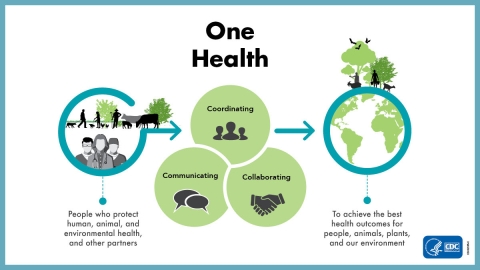Have you been paying more for eggs recently? One of the reasons for the increasingly expensive grocery staple is an outbreak of avian influenza in the United States and in Europe. Avian influenza occurs naturally in wild aquatic birds and is spread when these birds migrate and shed the virus through feces, saliva, and nasal secretions. As of May 31, 2023, more than 58 million domestic birds have been affected by the current outbreak, including widespread losses of egg-laying hens, and thus contributing to the higher egg prices seen across the country. This form of avian influenza also infects wild birds and humans (though the risk to human health is currently considered low).
This is a prime example of the intersection and interdependence of animal, human, and environmental health, a concept known as One Health.
The One Health approach recognizes the interdependence of the health of humans, domestic and wild animals, plants, and the wider environment (including ecosystems). This approach mobilizes multiple diverse sectors, disciplines, and communities to work together to promote well-being and address health and ecosystem threats. Outbreaks of zoonotic diseases (diseases that can spread between animals and humans), like the those that have caused the current avian influenza outbreak and the COVID-19 pandemic, starkly underscore the need for One Health solutions that effectively address these intersections.
How does international wildlife conservation contribute to One Health outcomes? Healthy habitats and wildlife populations contribute to resilient ecosystems, which reduce the risk of disease outbreaks among both wildlife and human communities. In short, the U.S. Fish and Wildlife Service (Service) protects the biodiversity that protects us. The Service’s International Affairs (IA) program promotes One Health outcomes abroad and at home through a variety of approaches, including:
- Providing financial and technical support to conservation projects around the world to protect healthy wildlife populations and intact, connected habitats.
- Supporting projects that implement holistic conservation interventions by including local communities as partners in wildlife conservation. These efforts include promoting sustainable livelihoods, wildlife-friendly livestock grazing practices, and effective protected area management.
- Supporting efforts to reduce the commercial bushmeat trade, which drives both biodiversity loss and risks spillover and transmission of diseases like Ebola.
- Regulating international wildlife trade by issuing permits and certificates authorizing the import, export, and re-export of wildlife, which are predicated on certain findings related to legality, traceability, and biological sustainability. Regulating such trade protects native wildlife from disease introduction and reduces health risks inherent in trade to both humans and animals.
As one example, IA and other Service programs took action to protect native salamanders from a lethal emerging fungal disease in 2016. The Service listed 201 salamander species as “injurious” under the Lacey Act for their potential to introduce Batrachochytrium salamandrivorans, or Bsal, to native amphibians in the United States. This designation prohibits the import of these salamander species into the United States without a Service-issued permit (administered through IA’s Branch of Permits). To date, Bsal has not been detected in the United States.
IA also works to save wild apes through disease investigation, monitoring, and mitigation. In 2021, the Great Ape Conservation Fund, administered by IA, supported three health-related projects to study emerging pathogens in chimpanzees in Sierra Leone, monitor mountain gorillas and eastern chimpanzees for parasites in Uganda, and ensure the health of captive Grauer’s gorillas before their reintroduction to the wild in the Democratic Republic of the Congo.
IA also engages in One Health solutions through participation in international fora. In 2022, the Service proposed a plan to improve the international transport of live animals at a global meeting of the Conference of the Parties to CITES (Convention on the International Trade of Endangered Species of Wild Fauna and Flora). The other Parties supported the U.S. initiative and the resulting effort will allow air transport and law enforcement officials around the world to more easily access transport guidelines to ensure that live CITES-listed animals are moved across country borders safely and in healthy conditions. In this way, the Service collaborates with international partners to strengthen the role of CITES in addressing disease and health risks in international wildlife trade.
IA’s decades-long work to protect healthy wildlife populations and ecosystems and to promote holistic conservation initiatives globally are vital frontline defenses against zoonotic spillover. Many of our efforts mitigate outbreaks or pandemics and contribute to the Service’s One Service, One Heath initiative to produce One Health outcomes for the benefit and well-being of animals, humans, and our shared environment.







